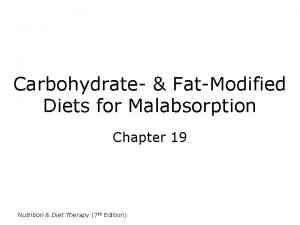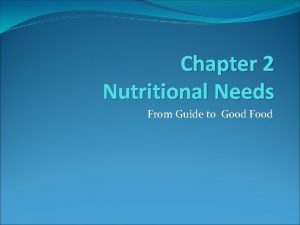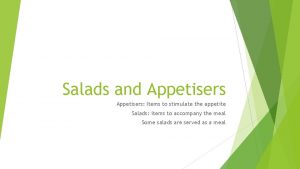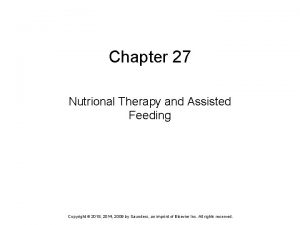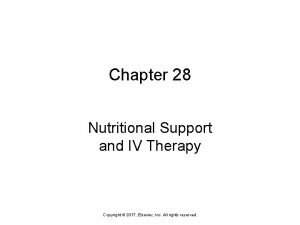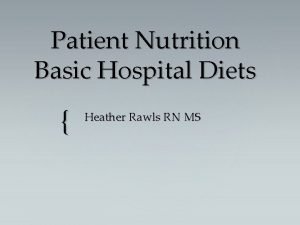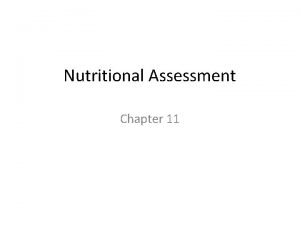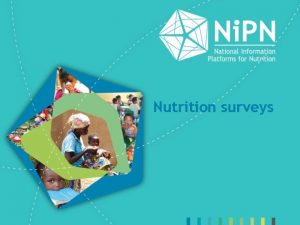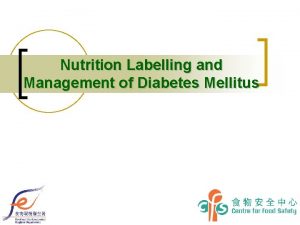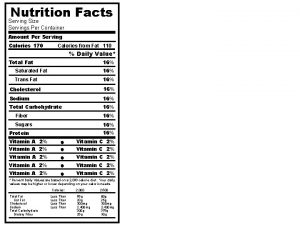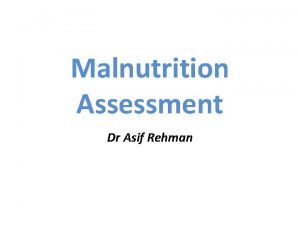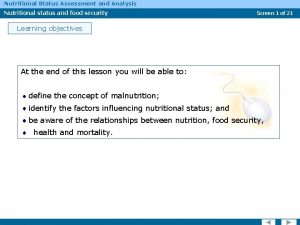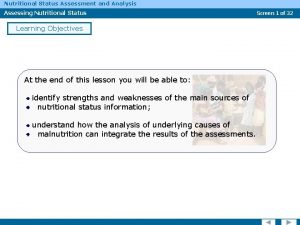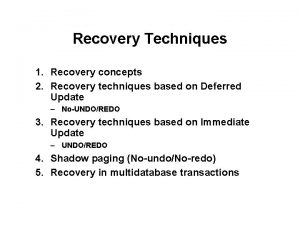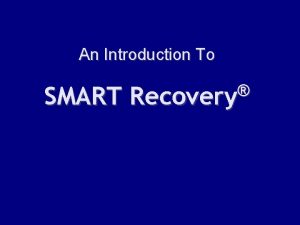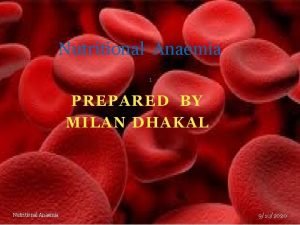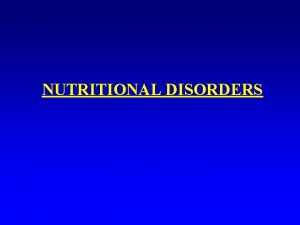Strategies to enhance performance and recovery Nutritional needs





































- Slides: 37

Strategies to enhance performance and recovery

Nutritional needs of athletes: a balanced diet It does not matter whether you are an international athlete, a regular club participant or a weekend fun-runner, it is essential that all athletes consume the correct balance of nutrients to supply their body with the energy needed for physical activity and to aid in recovery after exercise.

Nutritional needs of athletes: a balanced diet Good nutrition is vital for all of us, not only in the choice of foods we ingest, but also with timing and quantity of foods consumed. The essential nutrients required by all athletes include: �carbohydrates �fats �proteins �vitamins �minerals �water �fibre.

Nutritional needs of athletes: a balanced diet Each sport has different nutritional requirements. No set dietary regime will cater for all athletes' individual needs. However, there are some common nutritional principles

Nutritional needs of athletes: a balanced diet Athletes must develop their own individual eating plans to achieve maximum results from their training programs. The plan must be specific to the sporting event in which they participate, and it must ensure maximum fuel stores.

Nutritional needs of athletes: a balanced diet Athletes need to: �achieve optimum intake of all nutrients specific to their sport and their own sporting needs �ensure recovery between training sessions and after competition �account for any special dietary requirements for the event and/or themselves �make their plan enjoyable and suitable to their tastes and training regime �drink plenty of fluid.

Nutritional needs of athletes: carbohydrates

Nutritional needs of athletes: carbohydrates As we discovered in chapter 2, foods rich in carbohydrate play a vital role in exercise performance because they are the most readily available and versatile source of energy to fuel working muscles.

How much carbohydrate? A guideline of 7– 10 grams of carbohydrate per kilogram body mass (BM) is appropriate for an athlete. This can be achieved by planning meals to ensure this target level is met. Table 10. 1 is a guide to carbohydrate intake for the athlete.

How much carbohydrate? Carbohydrates predominantly supply energy for high-intensity, short-duration activities, such as sprinting 200 metres or repeated work periods during a game of football, but they can also supply energy for sub-maximal, longer-duration activities, such as a 1500 -metre swim or 5 -kilometre jog. So, the body uses glycogen as one of its major fuels during exercise.

How much carbohydrate? Because of the importance of carbohydrate as a fuel for providing energy, athletes need to continually top up carbohydrate stores to ensure there is enough in the muscles before the start of training and competition. Add to this the body's limited capacity to store carbohydrates, and you can see the importance of an athlete consuming carbohydrate before, during and after their performance in order to achieve optimal performance.

How much carbohydrate? Carbohydrate should make up 55– 65 per cent of total daily food intake, although athletes in heavy training need higher levels to ensure they restore muscle glycogen levels each day.

How much carbohydrate? Situation Recommended carbohydrate intake Daily refuelling needs for training programs less than 60– 90 minutes per day or low-intensity exercise Daily intake of 5– 7 grams per kilogram BM Daily refuelling for training programs Daily intake of 7– 10 grams per greater than 90– 120 minutes per kilogram BM day Daily refuelling for athletes undertaking an extreme exercise Daily intake of 10– 12+ grams per program: 6– 8 hours per day (cycling kilogram BM tour) Carbohydrate loading for endurance Daily intake of 7– 10 grams per and ultra-endurance events (see kilogram BM section 10. 4)

How much carbohydrate? Situation Recommended carbohydrate intake Pre-event meal (meal eaten 1– 4 hours pre-competition) 1– 4 grams per kilogram BM Carbohydrate intake during training sessions and competition events longer than 1 hour 1 gram per minute or 30– 60 grams per hour Intake of 1– 1. 5 grams per kilogram Rapid recovery after training session BM for every hour in the early stages or multi-day competition, especially of recovery after exercise, when there is less than 8 hours until contributing to a total intake of 6– 10 next session grams per kilogram BM over 24 hours

Application of the glycaemic index In chapter 2, the concept of the glycaemic index (GI) was introduced. You may recall that the glycaemic index refers to a scale that ranks carbohydrates by how much they raise blood-glucose levels compared with a reference food (glucose).

Foods that have a high glycaemic index (70 and above) are digested quickly, resulting in a rapid and high increase in blood-glucose levels. On the other hand, foods with a low glycaemic index (55 and less) are digested more slowly, resulting in a more gradual and less rapid rise in blood-glucose levels (see figure 10. 2).

Rate of release of glucose for foods with a high and low glycaemic index

Application of the glycaemic index Knowledge of the glycaemic index allows athletes, coaches and sports dietitians to determine what carbohydrate foods to eat and when to eat them. Manipulated correctly, this can enable the athlete to optimise their carbohydrate availability and thereby optimally enhance their performance and recovery.

Application of the glycaemic index Put more simply, there would appear to be times when foods with a low glycaemic index provide an advantage, and times when foods with a high glycaemic index are better. For best performance, athletes need to understand which foods have high and low glycaemic index ratings and when it is best to eat them.

Pre-event Carbohydrate(CHO) intake �(aimed to maximise glycogen stores and availability of glucose) � 3 -4 hours prior to the event a light meal with moderately high GI should be eaten. � 1 -2 hours prior to the event: A small snack with high GI should be eaten. �less than 1 hour prior to exercise: sports drinks and lollies should be consumed with high GI.

During the event �High GI foods can be eaten as these top up glycogen stores and can prevent fatigue cause by running out of glycogen. A popular alternative to foods during the event may be CHO gels which are concentrated fluids with high GI content they are often taken with water to not upset the stomach but they allow for a large amount of quick and ready to use glucose.

Post-event Carbohydrate intake �(aimed to replenish glycogen stores. ) �Best done in the time frame of 30 -60 minutes post exercise as this is when the body is looking to uptake glucose to replenish stores. �The food or drink should be high GI and low in fibre.

Strategies used to increase and preserve glycogen stores Glycogen sparing Is a result of aerobic training that can be used in long distance endurance events where the athlete has a highly developed aerobic system so that instead of using glycogen stores they can oxidize fats to provide ATP for exercise this enables them to spare oxygen without decreasing intensity. This allows the athlete to work at a higher intensity for longer before glycogen stores run out.

Carbohydrate loading Is where the athlete consumes larger amounts of carbohydrates in their diet prior to an event so that their glycogen stores are full. This will ensure that they do not experience fatigue as a result of glycogen depletion.

Michael Phelps Diet Olympic gold medallist Michael Phelps’ diet includes lots of food when he is training. Phelps trains six days a week and exercises five hours a day, so he is using up the calories that he consumes. He revealed his typical daily diet during an interview that amazed everyone to hear that his breakfast alone includes three fried egg sandwiches with a lot of cheese, lettuce, tomato, fried onions, and mayonnaise. That is only the beginning though. He also drinks two cups of coffee, and eats a five egg omelette, one bowl of grits, which are a maize porridge, three slices of French toast with powdered sugar, and three chocolate chip pancakes.

Michael Phelps Diet Most people eat that much in two days, but Michael Phelps’ diet must give him the energy he needs. For lunch, he then has one pound of pasta with tomato sauce, two large ham and cheese sandwiches with mayonnaise on white bread, plus energy drinks that equal around 1, 000 calories. Dinner includes another pound of pasta with sauce, a whole pizza of six Or eight slices, and more energy drinks

Tour de France Read the following article at: http: //www. cyclingweekly. co. uk/news/ra cing/tour-de-france/this-is-what-youhave-to-eat-to-compete-in-the-tour-defrance-182775

Nutritional needs of athletes: protein and fats

Protein has several important functions in the body. These include: �formation and growth of body tissues, especially muscle tissue and cells �repair and recovery of damaged tissues such as muscle tissue �production of red blood cells, hormones, antibodies and enzymes �provision of emergency fuel during exercise when carbohydrate and fat stores are depleted.

Protein is broken down through digestion into amino acids, of which there are two types: �essential amino acids — cannot be made by the body, so must be consumed �non-essential amino acids — can be made from other amino acids in the body.

Protein Animal foods such as meat, poultry, fish, eggs and dairy food are rich in protein and contain all the essential amino acids. Plant foods such as breads, breakfast cereals, grains, lentils, beans and peas are good protein sources, but they miss at least one essential amino acid so they should be eaten with other plant or animal sources.

How much protein? Protein is an important part of an athlete's diet and it plays a key role in post-exercise recovery and repair. Nutritionists recommend that protein contributes up to 15 per cent of total daily food intake; however, strength athletes may require additional amounts of protein for growth of muscle tissue as a consequence of their training.

How much protein? Most athletes would meet their daily protein requirement just through consuming a balanced diet. It has been found that additional amounts of protein are naturally ingested when the athlete increases their food intake in response to an increased training load. This is because many high-carbohydrate foods are also rich in protein; for example, bread, rice, pasta and baked beans. A guideline of 1– 2 grams of protein per kilogram of body mass (BM) is recommended

When to consume Recent research conducted at the Australian Institute of Sport (AIS) now suggests it is not necessarily the increased amount of protein that can lead to gains in lean-muscle tissue, but rather the timing of the protein intake for the athlete. It is important that athletes consume foods that contain protein (amino acids) as part of their posttraining or post-competition recovery process.

Protein supplementation Athletes may require a supplement when consumption of food is difficult post exercise and products such as liquid meal supplements offer convenience and a practical solution to consuming adequate protein.

Fats �Fats are important as they are the predominant fuel used at sub-maximal intensities. �At rest as fats provide high amounts of energy. �Athletes that are highly trained are able to use fats over glucose at the beginning of exercise in order to preserve glycogen stores.

Fats Fat is an important source of stored energy because it: �produces more energy per gram than all other nutrients (38 kilojoules per gram compared with 17 kilojoules per gram for protein and carbohydrate) �makes up to 50 per cent of the body's everyday energy �carries fat-soluble vitamins A, D, E and K, which are important in the metabolism of energy fuels. Fats also contribute to the taste, texture and aroma of food; provide protection for certain organs; and help produce cell membranes, skin hormones and cholesterol.
 Ftt criteria
Ftt criteria Fat malabsorption
Fat malabsorption Chapter 2 nutritional needs
Chapter 2 nutritional needs Nutritional needs in fundamentals of nursing
Nutritional needs in fundamentals of nursing Nutritional needs throughout the life cycle
Nutritional needs throughout the life cycle Primary needs and secondary needs
Primary needs and secondary needs Primary needs and secondary needs
Primary needs and secondary needs Primary needs and secondary needs
Primary needs and secondary needs Strategic gender needs and practical gender needs
Strategic gender needs and practical gender needs Need analysis esp
Need analysis esp Grammar to enrich and enhance writing
Grammar to enrich and enhance writing Psychological recovery strategies
Psychological recovery strategies Articles added to complete or enhance an outfit
Articles added to complete or enhance an outfit Enhance an image
Enhance an image A new backbone that can enhance learning capability of cnn
A new backbone that can enhance learning capability of cnn Vcosmetics
Vcosmetics Enhance an image
Enhance an image Enhance life
Enhance life Enhance life
Enhance life A salad to stimulate appetite
A salad to stimulate appetite Can hypnosis force people to act against their will
Can hypnosis force people to act against their will Chapter 24 nutritional care and support
Chapter 24 nutritional care and support Chapter 27 nutritional therapy and assisted feeding
Chapter 27 nutritional therapy and assisted feeding Nutrition epidemiology definition
Nutrition epidemiology definition Chapter 28 nutritional support and iv therapy
Chapter 28 nutritional support and iv therapy Chapter 28 nutritional support and iv therapy
Chapter 28 nutritional support and iv therapy Chapter 28 nutritional support and iv therapy
Chapter 28 nutritional support and iv therapy Valoarea nutritionala a alimentelor
Valoarea nutritionala a alimentelor Hypnum sp nutritional habits
Hypnum sp nutritional habits As nutritional energy passes through the food chain energy
As nutritional energy passes through the food chain energy Abcd of nutritional assessment
Abcd of nutritional assessment Nutritional status assessment
Nutritional status assessment Chapter 11 nutrition and diets
Chapter 11 nutrition and diets Objectives of nutrition
Objectives of nutrition Nutritional management of diabetes mellitus
Nutritional management of diabetes mellitus Servings per container 60
Servings per container 60 Malnutrition types
Malnutrition types Major nutritional deficiency diseases in emergencies
Major nutritional deficiency diseases in emergencies

